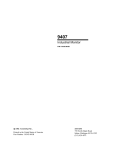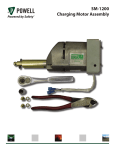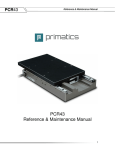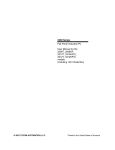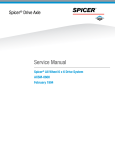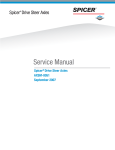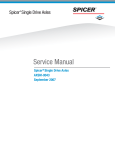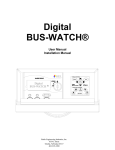Download Service Manual
Transcript
Spicer Drive Axles ® Service Manual AXSM0029 September 2007 General Information General Information The description, testing procedures, and specifications contained in this service publication were current at the time of printing. Dana reserves the right to discontinue or modify its models and/or procedures and to change specifications at any time without notice and without incurring obligation. The recommendations of the vehicle manufacturer should be considered as the primary source of service information regarding this Spicer product. This manual is intended to be used as a supplement to such information. Any reference to brand names in this publication is made simply as an example of the types of tools and materials recommended for use and, as such, should not be considered as an endorsement. Equivalents, if available, may be used. IMPORTANT NOTICE This symbol is used throughout this publication to call your attention to areas in which carelessness or failure to follow specific procedures may result in personal injury and/or component malfunction or damage. WARNINGS: Used in areas where failure to follow listed procedures creates a high probability of personal injury to the servicing technician. Anyone departing from the instructions contained in this publication through procedures used or choice of tools, materials and parts may jeopardize his personal safety and/or the safety of the vehicle user. CAUTIONS: Used in areas where failure to follow listed procedures may cause personal injury due to component damage or subsequent malfunction. Always use genuine Spicer replacement parts. Table of Contents Electric Shift System Air Shift System Introduction Electric Shift System . . . . . . . . . . . . . . . . . . . . . . . . . 1 Mechanical Operation . . . . . . . . . . . . . . . . . . . . . . . . 2 Troubleshooting . . . . . . . . . . . . . . . . . . . . . . . . . . . . 5 Shift Unit Removal/Disassembly Remove Shift Unit . . . . . . . . . . . . . . . . . . . . . . . . . . . 8 Remove Slider Block . . . . . . . . . . . . . . . . . . . . . . . . . 8 Remove Circuit Board and Motor . . . . . . . . . . . . . . . 9 Remove Gear and Cam Pins . . . . . . . . . . . . . . . . . . 10 Cleaning. . . . . . . . . . . . . . . . . . . . . . . . . . . . . . . . . . 10 Lubrication . . . . . . . . . . . . . . . . . . . . . . . . . . . . . . . 10 Sealing. . . . . . . . . . . . . . . . . . . . . . . . . . . . . . . . . . . 10 Shift Unit Assembly/Installation Install Cam Pins and Gear . . . . . . . . . . . . . . . . . . . . Install Slider Block . . . . . . . . . . . . . . . . . . . . . . . . . . Install Motor . . . . . . . . . . . . . . . . . . . . . . . . . . . . . . Install Circuit Board . . . . . . . . . . . . . . . . . . . . . . . . . Install Shift Unit . . . . . . . . . . . . . . . . . . . . . . . . . . . . 11 12 13 14 15 Air Shift System Description . . . . . . . . . . . . . . . . . . . . . . . . . . . . . . . Operation . . . . . . . . . . . . . . . . . . . . . . . . . . . . . . . . Air Shift Unit . . . . . . . . . . . . . . . . . . . . . . . . . . . . . . Description and Operation (Shift Unit) . . . . . . . . . . Troubleshooting . . . . . . . . . . . . . . . . . . . . . . . . . . . 19 19 20 20 21 Shift Unit Removal/Disassembly Remove Shift Unit . . . . . . . . . . . . . . . . . . . . . . . . . . Disassemble Shift Unit . . . . . . . . . . . . . . . . . . . . . . Lubrication . . . . . . . . . . . . . . . . . . . . . . . . . . . . . . . Parts Inspection . . . . . . . . . . . . . . . . . . . . . . . . . . . 22 22 23 23 Shift Unit Assembly/Installation Assemble Shift Unit. . . . . . . . . . . . . . . . . . . . . . . . . 24 Install Shift Unit . . . . . . . . . . . . . . . . . . . . . . . . . . . 25 Air Shifter Valve Removal/Disassembly Remove/Disassemble Air Shifter Valve . . . . . . . . . . 26 Inspection/Lubrication . . . . . . . . . . . . . . . . . . . . . . 26 Shift Unit Retrofit Kits Retrofitting Instructions. . . . . . . . . . . . . . . . . . . . . . 16 Air Shifter Valve Assembly/Installation Assemble/Install Air Shifter Valve . . . . . . . . . . . . . . 27 Servicing Other Electric System Components Installation of Improved Motor Housing Cover (Production units effective December 1989) . . . . . . 17 Speedometer Adapter . . . . . . . . . . . . . . . . . . . . . . . 18 Control Switch . . . . . . . . . . . . . . . . . . . . . . . . . . . . . 18 Servicing Other Air System Components Quick Release Valve . . . . . . . . . . . . . . . . . . . . . . . . 28 Pressure Switch . . . . . . . . . . . . . . . . . . . . . . . . . . . 28 Servicing Other Air System Components Additional Service Information . . . . . . . . . . . . . . . . 29 Parts Information . . . . . . . . . . . . . . . . . . . . . . . . . . 29 i Electric Shift System Introduction The service procedures and specifications in this publication cover the current Spicer 2-Speed Axle Shift Systems. Maintenance and overhaul instructions for the Spicer 2-Speed Axle carriers are covered in the publications listed on the back cover. This manual includes information on two types of Shift Systems currently in use for Spicer 2-Speed Axles; Electric and Air. Spicer 2-Speed Axles are driver-controlled by means of a shift unit operated from the vehicle cab. These shift units are activated by air or electric power depending on the convenient source in the chassis. Because of this variation, this publication is divided into two major segments: Electric Shift System for hydraulic-brake chassis and Air Shift System for air-brake chassis. Electrical Operation Note: For component identification and wiring schematic, refer to illustrations on pages 1, 2, 3, and 4. Unit in Low Range Shifting to High Range Current flows through upper contact of control switch, closed contacts of high-range switch, and motor to ground which starts the motor rotating. Current also continues from common motor terminal through low-range switch and to ground through the resistor. When motor starts, rotation of the gear allows cam ramp to apply pressure on low-range cam pin, which allows low range switch to open. The path to ground (through resistor) is open and the diode prevents speedometer adapter solenoid from being energized. Motor rotation continues to shift axle to high range. As shift is completed, cam ramp of gear releases high-speed cam pin to open high-range switch and creates an open circuit to turn off power to motor. Motor rotation is stopped quickly by means of dynamic braking through resistor. If, during rotation, driver decides to switch back to low range, motor continues to turn. ELECTRIC SHIFT UNIT CUTAWAY Wiring Harness and Connector Motor Circuit Board Assembly Cam Pin (Low Range) Switch Spring Gear Gear Pin (Eccentric) Black Wire Green Wire Red Wire Worm Gear Cam Pin (High Range) Slider Block Flat Washer (0.100", 2.54 mm thick) Opening of high-range switch has no effect since motor is now being powered by the circuit from control switch, through diode and low-range switch to ground at motor. In this instance, motor continues to turn until cam pin opens low-range switch to turn off power to motor. Unit in High Range Shifting to Low Range Current flows through control switch lower contact to energize speedometer adapter solenoid and through the diode and low-range switch to common motor terminal and ground at motor. Motor starts rotating. Current also flows through closed contact of high-range switch and to ground through resistor. Once gear rotates enough to apply cam pin pressure on the high switch, circuit to ground through resistor is open. As motor rotation continues to shift axle to low range, gear rotates and releases cam pin on low-range switch to open switch and open motor circuit. Motor power is turned off. Once again, the resistor portion of the circuit provides braking to stop motor quickly. If, during motor rotation, driver decides to shift back to high range, the motor continues to turn. Opening of low-range switch has no effect since motor is now being powered through control switch. In this instance, motor continues to turn until gear rotation opens high-range switch to open motor circuit. The shift unit always remains synchronized with position of driver's control switch. 1 Electric Shift System As motor shuts off at 180º of gear rotation, a break in torque by driver allows spring force (stored in the slider block assembly) to move the swivel pin and shift fork in appropriate direction for axle range change. Low to High Range or High to Low Range When shifting axle range either up or down, motor starts and turns worm gear shaft. The gear assembly (which is meshed with worm gear) turns and moves eccentric pin in slot area of slider block. When opposite axle range is selected by driver, the process is repeated by motor turning another 180º in same direction. In this case though, eccentric pin movement creates block spring compression in the opposite direction. Since driving torque holds shift fork and swivel block of the slider block assembly in place, linear motion of slider block is translated into compression of the internal spring. ELECTRIC SHIFT UNIT Cover Screw Housing Cover Cover Gasket Nut (Circuit Board) Cover Gasket (See Note below) Wiring Harness and Connector Circuit Board Assembly Red Wire Black Wire Green Wire Cam Pin Motor Housing Gear Washer Gear Gear Pin Board Flat Washer Nut (Gear Shaft) Worm Gear Motor Screw Motor Assembly Nut Cable Clip Motor Lead Wire Gear Shaft Slider Block & Shaft Assembly Electric Shift Unit Assembly Base Housing Housing Screw Dowel Pin Seal & Spring Nut Flat Washer (0.100", 2.54 mm thick) Stud Note: The new improved housing cover does not require a gasket (see page 17). 2 General Information Mechanical Operation Electric Shift System Shift System Electrical Wiring Schematic Circuit Board Resistor Ground Up-High Range Power Source (Ignition or Accessory Switch) Down-Low Range Black Motor High Range NC NO Ground Control Switch Circuit Breaker Wiring Harness Connector Speedometer Adapter Switches Switch Knob Housing Cover Diode Black Wiring Harness Green Red Ground Electrical Shift System Major Components Shift Unit Switch Plug and Cable Assembly Electric Shift Unit Speedometer Adapter Front Wiring Harness Rear Wiring Harness 3 Low Range NO NC Circuit Breaker or Fuse Electric Shift System General Information Slider Block Inspection Procedure Bottom of Base Housing • Remove shift unit from axle. • Move slider block from side to side. Make sure slider block moves freely in housing. 4 Electric Shift System Troubleshooting Troubleshooting Guide This chart begins with an improperly operating shift unit. Use with illustrations on pages 3, 4 and 6 to help isolate the problem. Follow the possible solutions as an aid to system repair. Axle doesn’t shift ranges. • Check the circuit breaker. • Is the circuit breaker closed? Yes Check for power at the shift unit connector. • Is there a voltage reading of 9V or more? Yes Remove shift unit from axle and apply voltage. • Does unit shift properly? Yes Inspect slider block from bottom of shift unit. See page 4 • Check to see if slider block is loose or missing. • Is slider block in good operating condition? Yes Inspect appearance of shift fork and check fit with depth card. • Does the fork match the depth card output? (See page 6) Yes Remove and inspect axle shift parts. • Are engagement surfaces severely worn, chipped or broken? Yes • Replace worn components. • Repeat troubleshooting procedure. 5 No • Reset circuit breaker or replace fuse. • Repeat troubleshooting procedure. No • Check the battery, cab switch, wire harness, and connectors. • Repeat troubleshooting procedure. No • Disassemble and service shift unit. (See page 8) • Repeat troubleshooting procedure. No • Replace slider block assembly (See page 8) • Repeat troubleshooting procedure. No • Rework or replace shift fork. • Repeat troubleshooting procedure. No End of diagnostics Electric Shift System Shift Fork Fit-up Card If interference at points A and B exists, carefully grind shift fork until it matches the fit-up card. Shift Fork Range Position Hi Shift Fork Range Position Shift Fork Fit-up Card (Part No. 128039) • Fit-up Card must set flush on mounting surface of axle • Shift fork must NOT touch Fit-up Card at points A and B 2-Speed Shift Fork Fit-Up Card FORWARD-REAR AXLE Figure 1 Lo General Information Checking Shift Fork Position and Alignment Electric shift unit failure or shifting problems may be caused by the shift fork binding on the slider block. Check the shift fork position and alignment with the Shift Fork Fit-Up card. Refer to the instructions on the card and the illustration below to check the shift fork. Shift Fork Fit-up Card Procedure: 1. Shift axle to high range so fork is square to axle face. 2. Remove shift unit and rubber boot. 3. Drop card over shift unit as shown in (fig. 1) until card touches carrier surface or interferes with fork. 4. If no interference, fork is OK. Go to step #6. 5. If card interferes at A or B, carefully grind fork to fit template. 6. Replace boot and reassemble unit. Printed in U.S.A. Dana service keeps you on the road. For technical assistance call 1-877-777-5360 anywhere in North America Part no. 128039 10M/1290/MP Copyright Dana 1991 All right reserved Lo Hi REAR-REAR AND SINGLE AXLES 6 Electric Shift System Parts Service Kits Expanded Service Kits Note: The new and improved housing cover does NOT require a gasket (see page 17). 7 SERVICE KIT NO. DESCRIPTION ITEMS INCLUDED 211319 Circuit Board and Cover Kit 1-7, 18-19 113745 Motor and Lube Kit 10, 18-19 113746 Drive Gear and Cam Pin Kit 5, 9, 12-14, 18 113759 Slider Block and Lube Kit 15, 18 113753 Connector and Harness Kit 20-26 Electric Shift System Shift Unit Removal/Disassembly Remove Shift Unit 3. 1. Shift axle to low range and park vehicle. 2. Disconnect wiring harness at shift unit. 3. Remove nuts, flat washers and shift unit from carrier. Lift out slider block and shaft assembly. Slider Block and Shaft Assembly 4. Removal / Disassembly Note: When shift unit is removed, provide container to catch oil that escapes from carrier. Remove shift unit seal and spring assembly. Remove Slider Block Note: To remove slider block, it is necessary to separate base housing from motor housing. Gasket compound may cause these housings to stick together. Use the motor as a handle to assist in separating the housings. If necessary, carefully pry housings apart using a thin-bladescrewdriver. 1. Remove cap screws fastening base housing to motor housing. 2. Lift motor housing off base housing. Base Housing Motor Housing 8 Electric Shift System Remove Circuit Board and Motor 1. Remove Circuit Board Washer Disconnect lead wires at cover terminals. Remove cover and gasket. Remove circuit board locknut. Circuit Board Locknut Lead Wires Cover Terminals HOUSING COVER REMOVAL 3. Remove circuit board mounting washer. Remove cap screws fastening cover to motor housing. Note: Gasket compound may cause cover to stick to housing. If necessary, carefully pry it loose, using a thin-blade screwdriver. 2. 4. 5. Remove cap screws fastening motor. 6. Lift motor to separate it from the housing. Note: Gasket compound may cause motor to stick to housing. If necessary, separate motor from housing by carefully prying, using a thin-blade screwdriver. 7. Remove motor, carefully guiding the motor wire and terminal through the housing hole. Lift circuit board out to gain access to motor lead wire (black). Disconnect this wire then remove circuit board. MOTOR REMOVAL Disconnect Motor Lead Wire Pry motor loose with screwdriver 9 Electric Shift System Remove Gear and Cam Pins 1. Remove gear locknut. Use deep-well socket while holding shaft end with locking pliers. 2. Remove ground lead wire. Cleaning After shift unit disassembly, clean all parts (with exception of the motor and circuit board), in a suitable commercial solvent. Dry with clean, lint-free cloth or compressed air before lubricating or reassembly. GEAR SHAFT LOCKNUT REMOVAL Make sure all residual gasket compound is removed from mating surfaces. WARNING: Gasoline is not an acceptable solvent because of its extreme combustibility. It is unsafe in the workshop environment. Lubrication Use locking pliers and deep-well socket to loosen nut 3. Lift shaft and gear assembly out of housing. Note: The cam pins are removed from the gear side of housing. Do not disturb the switch spring. 4. Lubrication of the shift unit is not required except when unit has been disassembled. Instructions are contained in the shift unit assembly procedures in this manual. Note: Use only “Rheolube 362” for shift lubrication. Use of other lube types may cause shift unit operational problems under certain low temperature conditions. A tube of this lubricant is included in Spicer Shift Unit Service Kits. It can also be purchased separately under Part No. 113741. Remove cam pins from housing. Remove cam pins from housing Sealing CAUTION CAUTION: Use approved gasket compound (Part No. 113771) to seal shift unit cover and other components. Standard RTV sealant may cause corrosion of electrical components. Proper sealing of the shift unit mating surfaces is essential for long life and trouble-free operation. For effective sealing, use approved gasket compound. During reassembly, make sure the mating surfaces are clean and that the compound pattern is not disturbed. Also, the gasket compound will set in 20 minutes. Assemble components before compound sets or reapply. 10 Removal / Disassembly WARNING Electric Shift System Shift Unit Assembly/Installation Install Cam Pins and Gear 2. Lubricate both sides of gear washer and gear face that contacts gear washer. Note: Use “Rheolube 362” lubricant during following reassembly procedures. Use of other lube types may cause operational problems under certain low temperature conditions. 1. Lubricate pins. Install pins in motor housing. Lubricate gear face Lubricate and install cam pins 3. Liberally apply lubricant on gear teeth. Completely fill cavities between teeth. 4. Lubricate the shoulder part of the gear shaft. Assemble shaft, gear and washer, then place this assembly in motor housing. Lubricate gear teeth 11 Electric Shift System 5. Also fill the cavity next to the gear with lubricant (cavity adjacent to motor shaft hole). Connect ground lead wire. Install gear locknut. While holding shaft end with locking pliers, torque locknut. SLIDER BLOCK LUBRICATION Install gear locknut 6. Connect ground lead wire After installation, rotate gear in a COUNTERCLOCKWISE direction to make sure binding is not present. Clockwise rotation is prevented by shift unit design. Lubricate 2. Note: It may be necessary to move the slider block in one direction or the other to engage the gear pin. Gear pin Rotate gear to check for binding Install Slider Block Use “Rheolube 362” lubricant during following reassembly procedures. Use of other lube types may cause operational problems under certain low temperature conditions. 1. SLIDER BLOCK INSTALLATION Apply a light film of lubricant to the full length of the slider block shaft. Fill entire slot area of slider block with lubricant (the area which engages gear pin). 12 Assembly / Installation Rotate gear to position the gear pin at 90 degrees from the slider block shaft centerline (see illustration below). Install slider block by nesting the block shaft in the recessed pockets in base housing. Electric Shift System 3. With housing mating surfaces clean, apply a continuous bead of approved gasket compound around the outer edge of the base housing. Align the dowel pin with hole in motor housing and assemble the two housings. Install Motor 1. Apply a continuous bead of approved gasket compound on motor base around motor shaft and lead wire. 2. Place motor on housing, guiding the lead terminal and wire through the proper opening and placing shaft through motor housing hole. 3. Install cap screws and tighten to correct torque. Apply gasket compound Apply gasket compound 4. Install housing cap screws loosely. Make sure that housings are mating properly by wiggling the slider block from side to side. 5. Torque housing cap screws. Note: There should be some slider block free play. If block is rigid, loosen cap screws, reposition block and tighten cap screws finger-tight. Recheck slider block free play. Move slider block from side to side to make sure housings are properly mated 13 Electric Shift System Install Circuit Board 1. 3. Install circuit board washer on gear shaft and on top of gear locknut. Install circuit board washer Install circuit board on gear shaft and install locknut. Torque locknut. IMPORTANT IMPORTANT: If a new housing cover is required, install the improved cover (see page 17 for instructions). Original cover is not available. Install circuit board assembly Install board locknut Connect motor lead wire to circuit board terminal. 4. To continue assembly of the shift unit when reusing the original cover, proceed as follows: 5. Apply RTV Electrical Grade Gasket Compound in (PN 113771) cover gasket groove. Install gasket. Apply gasket compound to gasket mating surface, circling screw holes. 6. Connect circuit board lead wires to cover terminals (see next illustration). Carefully push wires back in housing. Note: Exert care when repositioning lead wires to prevent smearing or destroying gasket compound. Connect motor lead 14 Assembly / Installation 2. Electric Shift System 7. Place cover in position on motor housing and install cap screws. Torque cover cap screws. Red Wire Install Shift Unit Note: Before installation, place shift unit in low range. This can be accomplished by connecting chassis wiring harness to shift unit cover and operating control switch (in cab), or apply 12-volt power supply to low range and ground terminals in shift unit cover (see wiring schematic, page 3). Green Wire Black Wire 1. Lubricate shift fork in seal area. Install seal and spring assembly on carrier. 2. Place shift unit on mounting studs, making certain shift unit actuating swivel pin engages slot in shift fork. Install flat washers (0.100", 2.54 mm thick) and nuts. 3. Torque nuts. Connect wiring harness. IMPORTANT Connect lead wires IMPORTANT: Before installing a rebuilt or replacement shift unit, check fit of shift fork using a “fit-up” card (see page 6). Note: Cover includes terminal identification for lead wires: B - Black, G - Green, R - Red inside and LO, GND and HI outside. 15 Electric Shift System Shift Unit Retrofit Kits 5. If shift unit does not operate, unplug new harness connector and test for power and voltage continuity at connector terminals. Note: In some special situations, the new unit cannot be used. Refer to appropriate Spicer Parts Books for detailed application and part no. information. The following instructions are a condensed version for retrofitting a new shift unit. Detailed instructions are contained in the Retrofit Kit. Wiring Harness Shift Unit Assembly Cable Clip Clip Nut Connect new wiring harness to new shift unit.* Check shift unit operation before mounting on differential carrier. Operate driver control switch in low and high range and observe new shift unit operation. If shift unit operates, install on carrier as follows: 6. Use new seal and spring assembly.* Mount seal on carrier studs. 7. Install shift unit. Install flat washers and nuts. Torque nuts. Note: Make sure to use the mounting washers* (0.100", 2.54 mm thick) furnished with kit. 8. Attach cable clip* to harness near motor and fasten to motor stud with nut*. Torque clip nut. 9. Secure harness to chassis with tie wraps.* Leave adequate slack to allow for axle movement. Flat Washer (2) IMPORTANT (0.100", 2.54mm thick) Connectors (3) Spring Seal Tie Wraps (2) COMPONENTS OF TYPICAL RETROFIT KIT IMPORTANT: Shift Unit Replacement. Before installing a rebuilt or new shift unit, check fit of shift fork to slide block pivot using a “Fit-up” Card or Template (PN 128039). These cards are furnished with new shift units retrofit and slide block kits. Instructions are contained on the card (see illustration) (also see page 6 instructions). Retrofitting Instructions *These parts are included in Retrofit Kit. 1. Remove existing shift unit. 2. Remove and discard seal and spring. 3. Cut existing wiring harness (approx. 6" - 8"). Identify wires (Low Range, High Range and ground). 4. Connect new wiring harness to existing harness, using connectors* furnished in kit. EXISTING WIRING HARNESS 2-Speed Shift Fork Fit-Up Card Procedure: 1. Shift axle to high range so fork is square to axle face. 2. Remove shift unit and rubber boot. 3. Drop card over shift unit as shown in (fig. 1) until card touches carrier surface or interferes with fork. 4. If no interference, fork is OK. Go to step #6. 5. If card interferes at A or B, carefully grind fork to fit template. 6. Replace boot and reassemble unit. Printed in U.S.A. Dana service keeps you on the road. For technical assistance call 1-877-777-5360 anywhere in North America Part no. 128039 10M/1290/MP Copyright Dana 1991 All right reserved NEW HARNESS* Ground to Green Wire (Ground) Low to Black Wire (Low) High to Red Wire (High) 16 Retrofit Kits The new Spicer Electric Shift Unit is a completely new design and shares no common parts with existing shift units. However, it is completely interchangeable as a unit for service replacement. Retrofit Kits are available to convert to the new shift unit. Electric Shift Sytem Servicing Other Electric System Components Installation of Improved Motor Housing Cover (Production units effective December 1989) CAUTION CAUTION: When removing material, use care to avoid filing into the threads of the motor mount fastener. See Detail Below The new cover (PN 113786) has a continuous sealing lip around the outside edge which improves sealing against road environment contamination. Previous cover is no longer available. Units currently in the field must be modified whenever a new cover is installed. Interference Area Cover Upper Housing Modification: Because the new cover encloses the entire rim of the units cast nose piece, the base of the motor mounting flange must be relieved slightly to prevent interference. Motor Note: This modification is only needed if a notch is NOT present in the motor housing flange. 1. Remove four (4) cover screws. Retain 3 screws. Note: The service kit includes a screw which is 1/4" longer than the previous cover screws. 2. 3. Place the new cover into position on the shift unit housing and draw a reference line on the motor base to show the width of the area to be modified. Using a file or small die grinder, remove material from the motor base (as shown in Fig. 1. The notch should be at least 0.100" (2.5mm) deep and 0.150" (3.8 mm) wide. Trial fit the cover during modification. 0.100" 2.5 mm Upper Housing 0.150" 4.0 mm Motor Fig. 1 - Electric Shift Unit Cover Fit Modifications 4. With the modification complete, install the new cover as follows: 5. Using RTV gasket compound (supplied with the service kit), apply a thin bead on top edge of motor housing. Note: The new cover does not require a gasket. CAUTION CAUTION: Always use RTV Electrical Grade Gasket Compound (PN 113771). Standard forms of RTV generate acetic acid which will damage shift unit components. Use gasket compound sparingly. Excessive use of compound could damage internal parts. 17 Electric Shift Sytem Speedometer Adapter Install long screw from kit in this location Install 3 previously removed screws in these locations Fig. 2 - Cover Screw Location Install the cover capscrews as shown in Fig. 2. Note: The 3 screws from prior installation should be used in all but the hole closest to the electrical connector. The new (longer) screw supplied with the kit must be installed in the hole shown. 7. Control Switch For inspection or replacement, the control switch can easily be removed by sliding the rubber boot up to the knob, then separate switch from harness. Inspect switch for loose connections and other visual defects that may cause short circuit or electrical failure. Replace a faulty switch as an assembly. Tighten all capscrews to 25-30 Lb.-In. (2.8-3.4 N.m) Do not over tighten. 18 Servicing Other Components 6. The speedometer adapter is lubricated and sealed for life of the unit. No maintenance is required. Replace a faulty unit. Air Shift System Air Shift System * For Vehicles Not Equipped with Automatic Safety Brakes + For Vehicles with Transmission Drive Speedometers Axle Shift Unit Quick Release Valve +Speedometer Adapter Exhaust 2-Speed Air Shifter Valve + Pressure Switch (normally closed) * Solenoid Valve White Dry Air Tank Red * Circuit Breaker Green Exhaust * Ignition or Accessory Switch Description Operation The basic system consists of: In operation, the air shifter valve (in gear shift knob) supplies air through the quick release valve to the axle shift unit. Air pressure in the shift unit shifts axle to High range. To shift axle to Low range, air pressure is exhausted at shifter valve, which exhausts air pressure at quick release valve, allowing shift unit to return to Low range. 1. A 2-position manually operated air shifter valve. 2. A quick release valve. 3. An air shift unit. The system operates at reservoir tank air pressure. For vehicles not equipped with automatic safety brakes, an ignition-controlled solenoid valve exhausts the system and down-shifts axle when ignition switch is turned off. The electrical circuit is protected by a circuit breaker. For vehicles equipped with transmission drive speedometer, the system includes a speedometer adapter. Operation is controlled by an electric switch (normally closed—opened by air pressure). This switch is mounted on or near the quick release valve. 19 Low Range Operation — Shifter knob is in “LO”, shifter valve is closed and no air pressure is present to shift unit. Axle is held in Low range by shift unit return spring. High Range Operation — Shifter knob is in “HI”, shifter valve is opened to allow air pressure through quick release valve to shift unit. Axle is held in High range by air pressure in the shift unit. Air Shift System Air Shift Unit “O” Ring Lock Nut Housing Cover (Piston End) Push Rod “O” Ring Lock Nut Washer Piston Compression Spring “O” Ring Felt Oilers Piston Stop Cap Screw (Plug) Screw and Washer Assembly Housing Cover Cover Gasket “O” Ring Cover Bolt Actuating Lever Pin Housing General Information Housing Bearing Oil Filler and Level Plug Cover Bearing Description and Operation (Shift Unit) The Air Shift Unit is engineered for efficient performance and built for reliable, service-free operation. Operation of the unit is as follows: The shift unit is mechanically connected to the axle shift fork and shifts axle into Low or High range. Clevis Pin Actuating Lever, Pin, and Block Assembly Note: A harsh environment kit (consisting of a vent filter and fittings) is available for shift units operating in unusually wet or dirty conditions. For additional information contact Dana Service Support. Note: Air Shift Units are also used on Spicer Controlled Traction Differential and Dual Range Tandem Axles. Refer to Spicer Service Manuals EA-47, EA-44 and EA-45. The unit consists of an air chamber, piston, compression spring and mechanical linkage. When air is admitted to the chamber or cylinder, the piston travels downward against a compression spring, transferring motion through a push rod and actuating lever to the shift fork, shifting the axle into High range. Exhaust of air pressure permits the heavy-duty spring to return the axle gearing to Low range. 20 Air Shift System Troubleshooting Check for Air Leaks 2. A simple method for quickly locating troubles in the system is to listen for possible air leaks and for sound which would indicate shift unit operation. Proceed as follows: 1. Turn ignition switch “ON” to energize and open solenoid valve. Move shifter knob to “HI”. In this position, air pressure should be present in the entire system. Check for air leaks. 2. With shifter knob in “LO”, air pressure should be present only up to the shifter valve. 3. To check axle for shifting, operate shifter knob back and forth from “LO” to “HI”. If the shift unit is operating, a definite reaction will be evident by sound of parts movement. 4. If air pressure is satisfactory and shift unit does not operate, disassemble and inspect shift unit. Check Pressure Switch In Low Range, the pressure switch is closed and electrical circuit is complete to the speedometer adapter. In High Range, air pressure opens the pressure switch, and breaks the electric circuit to the speedometer adapter. To check pressure switch operation, shift to High Range and probe switch terminals. No voltage should be present. Replace a faulty pressure switch as an assembly. Check Electrical System (with solenoid valve) 1. 21 When ignition switch is “ON” solenoid valve is energized and air pressure is available to operate the system. When ignition switch is “OFF”, solenoid valve is de-energized and exhausts the system which downshifts axle to low range. Check wiring and circuit breaker for defects that would cause shorts or open circuits. Make sure valve has a good ground connection to the frame. With power at valve, check operation as follows: Disconnect lead wire and air line outlet at valve and install air pressure gauge. Apply power to valve and observe air gauge reading. Operating pressure should be approximate reservoir pressure. If gauge indicates approximate pressure, valve is okay. If gauge indicates low or no pressure, valve is faulty. Replace valve assembly. Check Quick Release Valve The quick release valve provides a means of quickly exhausting air from system when axle is shifted from High to Low Range. To check valve operation, listen for audible air exhaust from valve when shifting axle from High to Low Range. Replace a faulty quick release valve as an assembly. Check Speedometer Adapter 1. Make sure adapter is grounded to vehicle chassis. 2. Check wiring for shorts or grounds and trace electrical circuit from ignition switch to speedometer adapter. 3. Check for power supply at adapter terminal. With air shifter valve in High Range, pressure switch is open and power is not delivered to adapter. With shifter valve in Low Range, the pressure switch is closed and power is delivered to operate the speedometer adapter. If power supply is okay, adapter is faulty. Replace adapter assembly. Air Shift System Removal / Disassembly Shift Unit Removal/Disassembly Remove Shift Unit 1. 4. Disconnect air line at shift unit cover. Remove nuts, flat washers and piston air shift unit from differential carrier. Compression Spring Note: When shift unit is removed, provide container to catch oil that escapes from reservoir. 2. Remove compression spring and piston stop from bore of shift unit housing. Remove shift fork seal and spring. Piston Stop Disassemble Shift Unit 1. Remove cap screws, lock washers, cover and gasket from housing. Drain lubricant. 2. Remove bolts, locknuts, and cover at piston end of housing. Remove “0” ring. “O” Ring CAUTION CAUTION: During the following procedure, the piston will pop out of housing under spring pressure. Exercise caution to prevent possible injury. 5. Remove clevis pin, then remove push rod from shift unit housing. Remove “0” ring from push rod. 6. Remove actuating lever and pin assembly from shift unit housing. Do not disassemble actuating lever. Piston Felt Oilers “O” Ring “O” Ring Actuating Lever Assembly Shift Fork Swivel Pin Compression Spring Actuating Lever Shift Unit Housing Piston Rod Clevis Pin 3. Remove locknut, flat washer, and piston from push rod. Remove “0” ring and felt oilers from piston. Actuating Lever Pin 22 Air Shift System Lubrication Parts Inspection Lubricant — Use SAE 10 motor oil* for temperatures above 0° F (-18° C). For temperatures below 0° F (-18° C), mix three parts of SAE 10 motor oil with one part of kerosene. This cold weather mixture can be safely used up to 32° F (0° C). Shift Fork Seal — Inspect shift fork seal for defects and tight fit on shift fork. A spring is used to assure a closer fit of seal around shift fork. If this spring is not present on axle being serviced, install one when reassembling unit. Note: *Commercially available automatic transmission fluid may be used in place of SAE 10 motor oil. Automatic transmission fluid can be used for all temperatures. Do not mix kerosene with automatic transmission fluid. “0” Rings, Felt Oilers and Gasket — Replace “0” rings, felt oilers and cover gasket when piston air shift unit is disassembled for repair. Lubricant Check and Level — Each 20,000 miles or six months, remove pipe plug in shift unit housing cover to check lubricant level. Lube should be level with bottom of filler hole. Lubricant Change — At least once a year remove shift unit housing cover and drain old lubricant. Wash parts thoroughly and air dry. Reinstall cover. Remove pipe plug in cover. Fill through pipe plug opening until lube is level with bottom of filler hole. 23 Compression Spring — Inspect spring for distortion, cracks, or other visual defects. Replace a faulty spring. Actuating Lever and Pins — Inspect lever pins and bearings for worn or grooved condition. Inspect actuating lever and push rod for worn or elongated holes at point where they are connected. Replace faulty parts. Piston — Inspect piston friction surface for worn, grooved or damaged condition which will affect the piston movement in cylinder. Replace a faulty piston. Air Shift System Shift Unit Assembly/Installation Assemble Shift Unit 4. Note: Prior to assembly, the piston felt oilers should be soaked in SAE 10 oil for one hour. Lubricate “0” rings with a high viscosity silicone oil or barium grease “0” ring lubricant. Assemble pin to actuating lever and install this assembly in shift unit housing. 2. Assemble “0” ring and piston to push rod and fasten with flat washer and locknut. Torque locknut. Install felt oilers and “0” ring on piston. PISTON AND PUSH ROD ASSEMBLY INSTALLATION PUSH ROD CLEVIS PIN INSTALLATION Press Actuating Lever Press Shift Unit Housing Assembly / Installation 1. Apply pressure to piston until actuating lever is in alignment with push rod end. Install clevis pin. Release press. Push Rod End Piston Locknut Clevis Pin Actuating Lever 5. Place cover gasket in position on shift unit housing then install cover and bearing assembly and fasten with cap screw and lock washers. If necessary, use a sealer on threads of cap screws to prevent any leaking. Torque cap screws. 6. Place “0” ring in groove of shift unit housing, then install housing cover and secure with bolts and locknuts. Torque locknuts. 7. Fill Shift unit with SAE 10 oil or automatic transmission fluid (see Lubrication page 23) when axle is installed in vehicle. Pin CAUTION CAUTION: During the following procedure using a press, make certain components are properly aligned in press to prevent possible personal injury or damage to parts. 3. Insert piston stop and compression spring in shift unit housing. Place piston and push rod assembly in housing. Position housing assembly in arbor press. 24 Air Shift System Install Shift Unit 25 1. Lubricate shift fork. Slide seal and spring assembly over fork and place on differential carrier studs. 2. Place shift unit on mounting studs and make certain shift fork actuating lever engages slot in shift fork. Install flat washers and stud nuts. Torque nuts. 3. When axle is installed in vehicle, fill shift unit housing to level of filler plug with SAE 10 oil. Coat threads of filler plug with sealer and install plug. 4. Connect air lines to shift unit cover. Air Shift System Air Shifter Valve Removal/Disassembly Remove/Disassemble Air Shifter Valve CAUTION CAUTION: Air supply to valve must be shut off before the valve is serviced. Inspection/Lubrication Each 50,000 miles, disassemble, inspect and clean, then lubricate moving parts with barium-base grease. No other type lubricant should be used. The shifter valve can be disassembled for service without removing the assembly from the gear shift lever. 1. Remove screw from cover, then lift off cover and remove shifter knob, knob spring, shifter plate, “0” ring guide and “0” ring from valve housing. 2. If housing requires replacement, disconnect air lines, loosen jam nut, then unscrew housing from shifter lever. AIR SHIFTER VALVE Cover Screw Cover Valve Removal / Disassembly “O” Ring “O” Ring Guide Shifter Plate Knob Spring Housing Shifter Knob Jam Nut 26 Air Shift System Air Shifter Valve Assembly/Installation Assemble/Install Air Shifter Valve 1. 2. If housing was removed, install jam nut on shift lever. Thread housing on shift lever and tighten jam nut. Connect air lines. Air shift valve knob should be positioned at 9:00 o'clock. Lubricate moving parts with barium-base grease during assembly. 4. Hold shifter plate in position with one hand, then install spring and shifter knob. Install cover and fasten with screw. SHIFTER KNOB INSTALLATION Place shifter plate in mounting position on valve housing. SHIFTER VALVE PLATE INSTALLATION Shifter Plate Valve Housing Shifter Knob Knob Spring 3. Pre-assemble guide and “0” ring, then place this assembly in mounting position in shifter plate. “O” RING AND GUIDE INSTALLATION “O” Ring “O” Ring Guide Shifter Plate 27 Air Shift System Servicing Other Air System Components Quick Release Valve The speedometer adapter is lubricated and sealed for life of the unit. No maintenance is required. Replace a faulty unit. If quick release valve fails to operate properly, it may be repaired as follows: Disassemble valve. Inspect valve body, valve seat and spring (if used) for evidence of faulty operation. Replace faulty parts, then reassemble valve. Servicing Other Components Speedometer Adapter Solenoid Valve Replace solenoid valve as an assembly. The valve should not be serviced. Pressure Switch Replace pressure switch as an assembly. 28 Shift Systems Additional Service Information Service information on 2-Speed Axle shifting components may be found in the appropriate Axle Service Publications. Parts Information Complete information for identifying replacement parts for 2Speed Shift Systems may be found in the appropriate Parts Publications. 29 For spec‘ing or service assistance, call 1-877-777-5360 or visit our website at www.dana.com Dana Commercial Vehicle Products Group 3939 Technology Drive Maumee, Ohio, USA 43537 www.dana.com All applications must be approved by the Application Engineering Department. Specifications and/or design are subject to change without notice or obligation. Printed in USA AXSM-0029 09/07

































